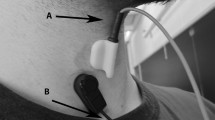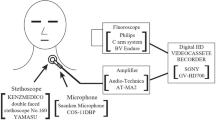Abstract
The aim of this study was to identify the origin of swallowing sound components by using modern techniques that can provide numeric, synchronized acoustic–radiologic data. We enrolled 15 volunteer subjects (10 men and 5 women, average age = 29.5 ± 8 years) and used an X-ray camera connected to a video acquisition card to obtain synchronized acoustic–radiologic data (25 images/s). The subjects were asked to swallow 10 ml of a barium suspension. Each sound component was associated with a specific position of the bolus and the anatomic structure that was moving. The average duration of the pharyngeal sound was 690 ± 162 ms. The durations of the laryngeal ascension sound and the laryngeal release sound were significantly different (72 ± 38 ms and 106 ± 47 ms, p < 0.001). The upper-sphincter opening sound was present in 100% of the recordings. Its duration was 185 ± 103 ms and was significantly different from the two other sounds. The duration of the first interval was 108 ± 44 ms and the duration of the second was 236 ± 139 ms. This study allowed us to determine the origin of the three main sound components of the pharyngeal swallowing sound with respect to movements in anatomic structures and the different bolus positions.



Similar content being viewed by others
References
Mackoviak RD, Brenman HS, Friedman MH. Acoustic profile of deglutition. Proc Soc Exp Biol Med 1967;123:1149–1152.
Lear CS, Flanagan JB, Mooress CF. The frequency of deglutition in man. Arch Oral Biol 1965;10:83–99.
Hamlet SL, Nelson RJ, Patterson RL. Interpreting the sound of swallowing: fluid flow through the cricopharyngeus. Ann Otol Rhinol Laryngol 1990;99:749–752.
Selley WG, Ellis RE, Flack FC, Bayliss CR, Pearce VR. The synchronization of respiration and swallow sounds with vidéofluoroscopy during swallowing. Dysphagia 1994;9:162–167.
Perlman AL, Ettema SL, Barkmeier J. Respiratory and acoustic signal associated with bolus passage during swallowing. Dysphagia 2000;15:89–94.
Klahn MS, Perlman AL. Temporal and durational patterns associating respiration and swallowing. Dysphagia 1999;14:131–138.
Kley C, Biniek R. Dysphagie: Sind schluckgerausche diagnostisch nutzbar? Nervenarzt 2005;76:1495–1505.
Boiron M, Delandrea E, Benchellal Z, Scotto B, Metman EH, Vincent N, Rouleau P. Acoustic-fluoroscopic exploration to assess bolus transit accross gastro-esophageal junction. Neurogastroenterol Motil 2002;14:581.
Morinière S, Boiron M, Beutter P. Sound component duration of healthy human pharyngoesophageal swallowing: a gender comparison study. Dysphagia 2006;21:175–182.
Takahashi K, Groher ME, Michi K. Methodology for detecting swallowing sound. Dysphagia 1994;9:54–62.
Martin-Harris B, Michel Y, Castell DO. Physiologic model of oropharyngeal swallowing revisited. Otolaryngol Head Neck Surg 2005;133:234–240.
Smith D, Hamlet S, Jones L. Acoustic technique for determining timing of velopharyngeal closure in swallowing. Dysphagia 1990;5:142–146.
Kendall KA, Mc Kenzie S, Leonard RJ, Goncalves MI. Timing of swallowing events after single-modality treatment of head and neck carcinomas with radiotherapy. Ann Otol Rhinol Laryngol 2000;109:767–775.
Perlman AL, He X, Barkmeier J, Van Leer E. Bolus location associated with videofluoroscopic and respirodeglutometric events. J Speech Hear Res 2005;48:21–33.
Cichero JA, Murdoch BE. Acoustic signature of the normal swallow: characterization by age, gender, and bolus volume. Ann Otol Rhinol Laryngol 2002;111:623–632.
Dodds WJ, Man KM, Cook IJ, Karhilas PJ, Stewart ET, Kern MK. Influence of bolus volume on swallow-induced hyoid movement in normal subjects. AJR Am J Roentgenol 1988;150:1307–1309.
Cichero JA, Murdoch BE. What happens after the swallow? Introducing the glottal release sound. J Med Speech Lang Pathol 2003;11:31–41.
Acknowledgments
The authors thank the French Research Ministry and the French ENT College for financial contribution to this study, and D. Schwartz for the English translation.
Author information
Authors and Affiliations
Corresponding author
Rights and permissions
About this article
Cite this article
Morinière, S., Boiron, M., Alison, D. et al. Origin of the Sound Components During Pharyngeal Swallowing in Normal Subjects. Dysphagia 23, 267–273 (2008). https://doi.org/10.1007/s00455-007-9134-z
Received:
Accepted:
Published:
Issue Date:
DOI: https://doi.org/10.1007/s00455-007-9134-z




